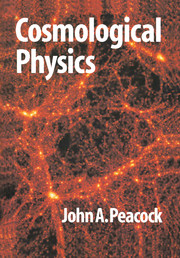Book contents
- Frontmatter
- Contents
- Preface
- Part 1 Gravitation and relativity
- Part 2 Classical cosmology
- Part 3 Basics of quantum fields
- Part 4 The early universe
- Part 5 Observational cosmology
- Part 6 Galaxy formation and clustering
- 15 Dynamics of structure formation
- 16 Cosmological density fields
- 17 Galaxy formation
- 18 Cosmic background fluctuations
- Hints for solution of the problems
- Bibliography and references
- Useful numbers and formulae
- Index
15 - Dynamics of structure formation
Published online by Cambridge University Press: 05 June 2012
- Frontmatter
- Contents
- Preface
- Part 1 Gravitation and relativity
- Part 2 Classical cosmology
- Part 3 Basics of quantum fields
- Part 4 The early universe
- Part 5 Observational cosmology
- Part 6 Galaxy formation and clustering
- 15 Dynamics of structure formation
- 16 Cosmological density fields
- 17 Galaxy formation
- 18 Cosmic background fluctuations
- Hints for solution of the problems
- Bibliography and references
- Useful numbers and formulae
- Index
Summary
Overview
The overall properties of the universe are very close to being homogeneous; and yet telescopes reveal a wealth of detail on scales varying from single galaxies to large-scale structures of size exceeding 100 Mpc (see figure 15.1). The existence of these cosmological structures tells us something important about the initial conditions of the big bang, and about the physical processes that have operated subsequently. This chapter deals with the gravitational and hydrodynamical processes that are relevant to structure formation; the following chapters apply these ideas to large-scale structure, galaxy formation and the microwave background. We will now outline the main issues to be covered.
origin and growth of inhomogeneities The aim of studying cosmological inhomogeneities is to understand the processes that caused the universe to depart from uniform density. Chapters 10 and 11 have discussed at some length the two most promising existing ideas for how this could have happened: either through the amplification of quantum zero-point fluctuations during an inflationary era, or through the effect of topological defects formed in a cosmological phase transition. Neither of these ideas can yet be regarded as established, but it is astonishing that we are able to contemplate the observational consequences of physical processes that occurred at such remote energies.
Information
- Type
- Chapter
- Information
- Cosmological Physics , pp. 457 - 494Publisher: Cambridge University PressPrint publication year: 1998
